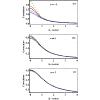当前位置:
X-MOL 学术
›
Phys. Rev. E
›
论文详情
Our official English website, www.x-mol.net, welcomes your
feedback! (Note: you will need to create a separate account there.)
Covariant Bethe-Salpeter approximation in models of strongly correlated electron systems
Physical Review E ( IF 2.2 ) Pub Date : 2020-02-20 , DOI: 10.1103/physreve.101.023310 Zhenhao Fan , Zhipeng Sun , Dingping Li , Itzhak Berenstein , Guy Leshem , Baruch Rosenstein
Physical Review E ( IF 2.2 ) Pub Date : 2020-02-20 , DOI: 10.1103/physreve.101.023310 Zhenhao Fan , Zhipeng Sun , Dingping Li , Itzhak Berenstein , Guy Leshem , Baruch Rosenstein

|
Strongly correlated electron systems are generally described by tight-binding lattice Hamiltonians with strong local (onsite) interactions, the most popular being the Hubbard model. Although the half-filled Hubbard model can be simulated by Monte Carlo (MC), physically more interesting cases beyond half-filling are plagued by the sign problem. One therefore should resort to other methods. It was demonstrated recently that a systematic truncation of the set of Dyson-Schwinger equations for correlators of the Hubbard, supplemented by a “covariant” calculation of correlators leads to a convergent series of approximants. The covariance preserves all the Ward identities among correlators describing various condensed matter probes. While first-order (classical), second-order (Hartree-Fock or Gaussian), and third-order (Cubic) covariant approximation were worked out, the fourth-order (quartic) seems too complicated to be effectively calculable in fermionic systems. It turns out that the complexity of the quartic calculation in local interaction models,is manageable computationally. The quartic (Bethe-Salpeter-type) approximation is especially important in 1D and 2D models in which the symmetry-broken state does not exists (the Mermin-Wagner theorem), although strong fluctuations dominate the physics at strong coupling. Unlike the lower-order approximations, it respects the Mermin-Wagner theorem. The scheme is tested and exemplified on the single-band 1D and 2D Hubbard model.
中文翻译:

强相关电子系统模型中的协变Bethe-Salpeter逼近
高度相关的电子系统通常由具有强的局部(现场)相互作用的紧密结合的晶格哈密顿量来描述,其中最受欢迎的是哈伯德模型。尽管可以通过Monte Carlo(MC)模拟半填充的Hubbard模型,但符号问题困扰着物理上比半填充更有趣的情况。因此,一种应诉诸其他方法。最近证明,对于哈伯德相关器的戴森-舒温格方程组的系统截断,辅以相关器的“协变量”计算,可得出一系列收敛的近似值。协方差保留了描述各种凝聚物探针的相关器之间的所有Ward身份。一阶(古典),二阶(Hartree-Fock或高斯),和三阶(三次)协变近似被计算出来,四阶(四次)似乎太复杂了,无法在铁离子系统中有效地计算。结果表明,局部交互模型中四次计算的复杂性在计算上是可管理的。四阶(Bethe-Salpeter型)逼近在不存在对称破坏状态的1D和2D模型中(Mermin-Wagner定理)尤其重要,尽管在强耦合中,强波动起着物理作用。与低阶近似不同,它遵循Mermin-Wagner定理。该方案在单波段1D和2D Hubbard模型上进行了测试和示例。结果表明,局部交互模型中四次计算的复杂性在计算上是可管理的。四阶(Bethe-Salpeter型)逼近在不存在对称破坏状态的1D和2D模型中(Mermin-Wagner定理)尤其重要,尽管在强耦合中,强波动起着物理作用。与低阶近似不同,它遵循Mermin-Wagner定理。该方案在单波段1D和2D Hubbard模型上进行了测试和示例。结果表明,局部交互模型中四次计算的复杂性在计算上是可管理的。四阶(Bethe-Salpeter型)逼近在不存在对称破坏状态的1D和2D模型中(Mermin-Wagner定理)尤其重要,尽管在强耦合中,强波动主导着物理。与低阶近似不同,它遵循Mermin-Wagner定理。该方案在单波段1D和2D Hubbard模型上进行了测试和示例。它尊重Mermin-Wagner定理。该方案在单波段1D和2D Hubbard模型上进行了测试和示例。它尊重Mermin-Wagner定理。该方案在单波段1D和2D Hubbard模型上进行了测试和示例。
更新日期:2020-02-20
中文翻译:

强相关电子系统模型中的协变Bethe-Salpeter逼近
高度相关的电子系统通常由具有强的局部(现场)相互作用的紧密结合的晶格哈密顿量来描述,其中最受欢迎的是哈伯德模型。尽管可以通过Monte Carlo(MC)模拟半填充的Hubbard模型,但符号问题困扰着物理上比半填充更有趣的情况。因此,一种应诉诸其他方法。最近证明,对于哈伯德相关器的戴森-舒温格方程组的系统截断,辅以相关器的“协变量”计算,可得出一系列收敛的近似值。协方差保留了描述各种凝聚物探针的相关器之间的所有Ward身份。一阶(古典),二阶(Hartree-Fock或高斯),和三阶(三次)协变近似被计算出来,四阶(四次)似乎太复杂了,无法在铁离子系统中有效地计算。结果表明,局部交互模型中四次计算的复杂性在计算上是可管理的。四阶(Bethe-Salpeter型)逼近在不存在对称破坏状态的1D和2D模型中(Mermin-Wagner定理)尤其重要,尽管在强耦合中,强波动起着物理作用。与低阶近似不同,它遵循Mermin-Wagner定理。该方案在单波段1D和2D Hubbard模型上进行了测试和示例。结果表明,局部交互模型中四次计算的复杂性在计算上是可管理的。四阶(Bethe-Salpeter型)逼近在不存在对称破坏状态的1D和2D模型中(Mermin-Wagner定理)尤其重要,尽管在强耦合中,强波动起着物理作用。与低阶近似不同,它遵循Mermin-Wagner定理。该方案在单波段1D和2D Hubbard模型上进行了测试和示例。结果表明,局部交互模型中四次计算的复杂性在计算上是可管理的。四阶(Bethe-Salpeter型)逼近在不存在对称破坏状态的1D和2D模型中(Mermin-Wagner定理)尤其重要,尽管在强耦合中,强波动主导着物理。与低阶近似不同,它遵循Mermin-Wagner定理。该方案在单波段1D和2D Hubbard模型上进行了测试和示例。它尊重Mermin-Wagner定理。该方案在单波段1D和2D Hubbard模型上进行了测试和示例。它尊重Mermin-Wagner定理。该方案在单波段1D和2D Hubbard模型上进行了测试和示例。











































 京公网安备 11010802027423号
京公网安备 11010802027423号